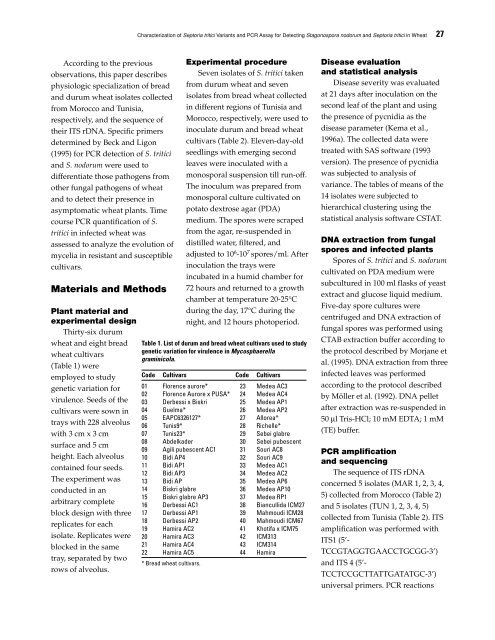Septoria and Stagonospora Diseases of Cereals - CIMMYT ...
Septoria and Stagonospora Diseases of Cereals - CIMMYT ...
Septoria and Stagonospora Diseases of Cereals - CIMMYT ...
You also want an ePaper? Increase the reach of your titles
YUMPU automatically turns print PDFs into web optimized ePapers that Google loves.
According to the previous<br />
observations, this paper describes<br />
physiologic specialization <strong>of</strong> bread<br />
<strong>and</strong> durum wheat isolates collected<br />
from Morocco <strong>and</strong> Tunisia,<br />
respectively, <strong>and</strong> the sequence <strong>of</strong><br />
their ITS rDNA. Specific primers<br />
determined by Beck <strong>and</strong> Ligon<br />
(1995) for PCR detection <strong>of</strong> S. tritici<br />
<strong>and</strong> S. nodorum were used to<br />
differentiate those pathogens from<br />
other fungal pathogens <strong>of</strong> wheat<br />
<strong>and</strong> to detect their presence in<br />
asymptomatic wheat plants. Time<br />
course PCR quantification <strong>of</strong> S.<br />
tritici in infected wheat was<br />
assessed to analyze the evolution <strong>of</strong><br />
mycelia in resistant <strong>and</strong> susceptible<br />
cultivars.<br />
Materials <strong>and</strong> Methods<br />
Plant material <strong>and</strong><br />
experimental design<br />
Thirty-six durum<br />
wheat <strong>and</strong> eight bread<br />
wheat cultivars<br />
(Table 1) were<br />
employed to study<br />
genetic variation for<br />
virulence. Seeds <strong>of</strong> the<br />
cultivars were sown in<br />
trays with 228 alveolus<br />
with 3 cm x 3 cm<br />
surface <strong>and</strong> 5 cm<br />
height. Each alveolus<br />
contained four seeds.<br />
The experiment was<br />
conducted in an<br />
arbitrary complete<br />
block design with three<br />
replicates for each<br />
isolate. Replicates were<br />
blocked in the same<br />
tray, separated by two<br />
rows <strong>of</strong> alveolus.<br />
Characterization <strong>of</strong> <strong>Septoria</strong> tritici Variants <strong>and</strong> PCR Assay for Detecting <strong>Stagonospora</strong> nodorum <strong>and</strong> <strong>Septoria</strong> tritici in Wheat 27<br />
Experimental procedure<br />
Seven isolates <strong>of</strong> S. tritici taken<br />
from durum wheat <strong>and</strong> seven<br />
isolates from bread wheat collected<br />
in different regions <strong>of</strong> Tunisia <strong>and</strong><br />
Morocco, respectively, were used to<br />
inoculate durum <strong>and</strong> bread wheat<br />
cultivars (Table 2). Eleven-day-old<br />
seedlings with emerging second<br />
leaves were inoculated with a<br />
monosporal suspension till run-<strong>of</strong>f.<br />
The inoculum was prepared from<br />
monosporal culture cultivated on<br />
potato dextrose agar (PDA)<br />
medium. The spores were scraped<br />
from the agar, re-suspended in<br />
distilled water, filtered, <strong>and</strong><br />
adjusted to 106-107 spores/ml. After<br />
inoculation the trays were<br />
incubated in a humid chamber for<br />
72 hours <strong>and</strong> returned to a growth<br />
chamber at temperature 20-25°C<br />
during the day, 17°C during the<br />
night, <strong>and</strong> 12 hours photoperiod.<br />
Table 1. List <strong>of</strong> durum <strong>and</strong> bread wheat cultivars used to study<br />
genetic variation for virulence in Mycosphaerella<br />
graminicola.<br />
Code Cultivars Code Cultivars<br />
01 Florence aurore* 23 Medea AC3<br />
02 Florence Aurore x PUSA* 24 Medea AC4<br />
03 Derbessi x Biskri 25 Medea AP1<br />
04 Guelma* 26 Medea AP2<br />
05 EAPC6326127* 27 Allorea*<br />
06 Tunis9* 28 Richelle*<br />
07 Tunis23* 29 Sebei glabre<br />
08 Abdelkader 30 Sebei pubescent<br />
09 Agili pubescent AC1 31 Souri AC8<br />
10 Bidi AP4 32 Souri AC9<br />
11 Bidi AP1 33 Medea AC1<br />
12 Bidi AP3 34 Medea AC2<br />
13 Bidi AP 35 Medea AP6<br />
14 Biskri glabre 36 Medea AP10<br />
15 Biskri glabre AP3 37 Medea RP1<br />
16 Derbessi AC1 38 Biancullida ICM27<br />
17 Derbessi AP1 39 Mahmoudi ICM28<br />
18 Derbessi AP2 40 Mahmoudi ICM67<br />
19 Hamira AC2 41 Khotifa x ICM75<br />
20 Hamira AC3 42 ICM313<br />
21 Hamira AC4 43 ICM314<br />
22 Hamira AC5 44 Hamira<br />
* Bread wheat cultivars.<br />
Disease evaluation<br />
<strong>and</strong> statistical analysis<br />
Disease severity was evaluated<br />
at 21 days after inoculation on the<br />
second leaf <strong>of</strong> the plant <strong>and</strong> using<br />
the presence <strong>of</strong> pycnidia as the<br />
disease parameter (Kema et al.,<br />
1996a). The collected data were<br />
treated with SAS s<strong>of</strong>tware (1993<br />
version). The presence <strong>of</strong> pycnidia<br />
was subjected to analysis <strong>of</strong><br />
variance. The tables <strong>of</strong> means <strong>of</strong> the<br />
14 isolates were subjected to<br />
hierarchical clustering using the<br />
statistical analysis s<strong>of</strong>tware CSTAT.<br />
DNA extraction from fungal<br />
spores <strong>and</strong> infected plants<br />
Spores <strong>of</strong> S. tritici <strong>and</strong> S. nodorum<br />
cultivated on PDA medium were<br />
subcultured in 100 ml flasks <strong>of</strong> yeast<br />
extract <strong>and</strong> glucose liquid medium.<br />
Five-day spore cultures were<br />
centrifuged <strong>and</strong> DNA extraction <strong>of</strong><br />
fungal spores was performed using<br />
CTAB extraction buffer according to<br />
the protocol described by Morjane et<br />
al. (1995). DNA extraction from three<br />
infected leaves was performed<br />
according to the protocol described<br />
by Möller et al. (1992). DNA pellet<br />
after extraction was re-suspended in<br />
50 µl Tris-HCl; 10 mM EDTA; 1 mM<br />
(TE) buffer.<br />
PCR amplification<br />
<strong>and</strong> sequencing<br />
The sequence <strong>of</strong> ITS rDNA<br />
concerned 5 isolates (MAR 1, 2, 3, 4,<br />
5) collected from Morocco (Table 2)<br />
<strong>and</strong> 5 isolates (TUN 1, 2, 3, 4, 5)<br />
collected from Tunisia (Table 2). ITS<br />
amplification was performed with<br />
ITS1 (5’-<br />
TCCGTAGGTGAACCTGCGG-3’)<br />
<strong>and</strong> ITS 4 (5’-<br />
TCCTCCGCTTATTGATATGC-3’)<br />
universal primers. PCR reactions









